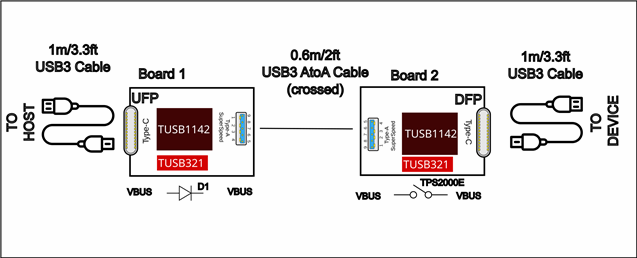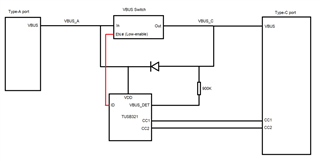Other Parts Discussed in Thread: TUSB321, , TPS2000E, TPS2001E, TPS2556, TPS2557, TUSB320
Hello. As described in a previous post I have to design a board to drive and USB from an USB3 type-C connector to another USB3 connector at a distance of about 0.6m/2ft.
Everything is powered by the HOST DFP port. I don't need to provide power to the device, I need only the data connection.

Here my project choices:
1. I planned to use TUSB1142 as driver and 2:1 and 1:2 mux. The DIR output of the TUSB321 drives the TUSB1142 FLIP input.
2. On board2 the UFP connector should be a type-B but, in order to have a single board, I put a type A since non standard A to A cables (crossed) are available on the market.
3. TUSB321 is used in dual role port mode (DRP).
4. Once TUSB321 has detected the port role and set the DIR and ID (max 133ms), the TUSB1142 EN pin rises, delayed by 400ms by the TLV802EF and the pin straps are acquired.
I would check if this management of the VBUS voltage is acceptable:
Board1:
- VBUS is driven directly from the type-C connector to the type-A connector through a Diode (Vf=250mV).
Board2:
- VBUS on the DFP Type-C connector is enabled by the TPS2000E switch driven by the ID pin of the TUSB321.
- The cable on the right side which connects the DFP to the device should be connected after the TUSB321 and the TUSB1142 EN pin is asserted.
Another question I have regards the FLIP input on the TUSB1142: it should not be latched with the EN pin and should change when a cable is inserted after the EN is asserted: is it correct?
Attached the schematic USB3DRV2.pdf.
Thank you.


